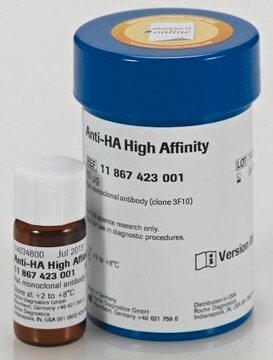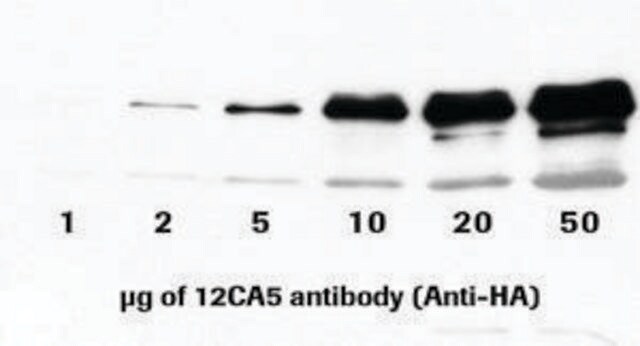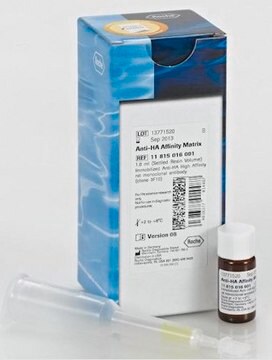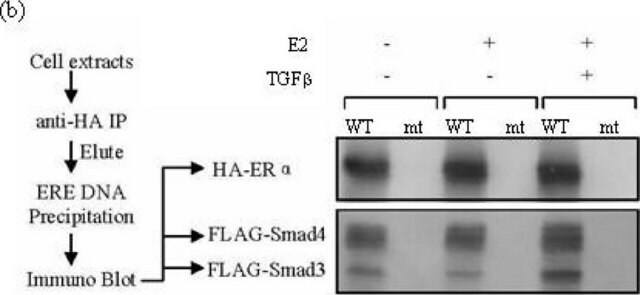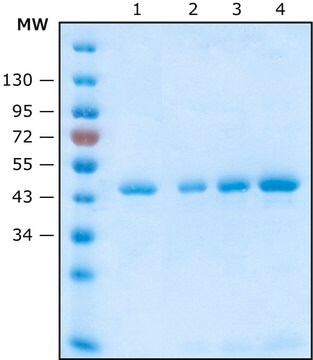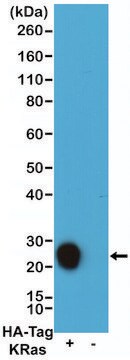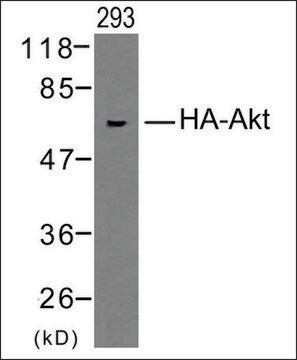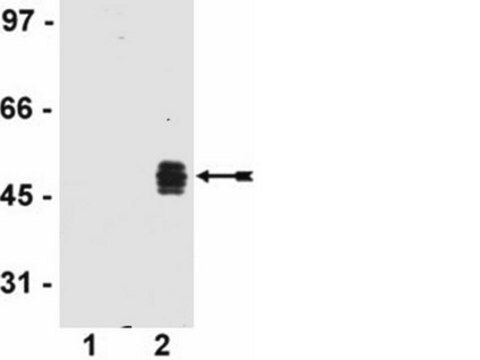12158167001
Roche
Anti-HA-Biotin, High Affinity (3F10)
from rat IgG1
Synonym(e):
antibody
Anmeldenzur Ansicht organisationsspezifischer und vertraglich vereinbarter Preise
Alle Fotos(1)
About This Item
UNSPSC-Code:
12352203
Empfohlene Produkte
Biologische Quelle
rat
Qualitätsniveau
Konjugat
biotin conjugate
Antikörperform
purified immunoglobulin
Antikörper-Produkttyp
primary antibodies
Klon
3F10, monoclonal
Form
lyophilized (stabilized)
Verpackung
pkg of 50 μg
Hersteller/Markenname
Roche
Isotyp
IgG1
Epitopsequenz
YPYDVPDYA
Lagertemp.
2-8°C
Verwandte Kategorien
Allgemeine Beschreibung
Anti-HA-Biotin, High Affinity (3F10) is a monoclonal antibody for the highly sensitive detection of HA-tagged recombinant proteins, Fab fragments, conjugated to biotin. The Anti-HA-Biotin, High Affinity antibody (clone 3F10) recognizes the same epitope as clone 12CA5. It is a monoclonal antibody whose high affinity and low working concentrations result in less cross-reactivity than with other antibodies to the HA-epitope. Anti-HA-Biotin, High Affinity (3F10) is a biotin conjugate of this clone which is specifically useful in western blotting, ELISA applications and assays using the universal biotin-streptavidin platform, by allowing specific and highly sensitive detection of HA-tagged proteins.
Spezifität
Anti-HA-Biotin, High Affinity (3F10) recognizes the 9-amino acid sequence YPYDVPDYA, derived from the human influenza hemagglutinin (HA) protein. This epitope is also recognized in fusion proteins regardless of its position (N-terminal, C-terminal or internal).
Immunogen
Amino acids 98-106 from the human influenza virus hemagglutinin protein
Anwendung
Anti-HA-Biotin, High Affinity (3F10) is used for the detection of HA-tagged recombinant proteins using:
It has also been used for immunocytochemistry, immunofluorescence and αScreen format based assay.
- Dot blots
- ELISA (enzyme-linked immunosorbent assay)
- Western blots
It has also been used for immunocytochemistry, immunofluorescence and αScreen format based assay.
Qualität
Function test: The Anti-HA-Biotin; High Affinity is function tested by Western blot analysis of a HA-tagged fusion protein.
Angaben zur Herstellung
Sample Materials
Sample preparation: Prepare protein extracts containing the HA-tagged protein of interest using any of a variety of standard methods. The following lysis buffers have performed well and should be taken as guidelines:
Sample preparation: Prepare protein extracts containing the HA-tagged protein of interest using any of a variety of standard methods. The following lysis buffers have performed well and should be taken as guidelines:
- Bacterial extracts: 20 mM Tris, pH 8.0, 100 mM NaCl, cOmplete Protease Inhibitor Cocktail Tablets, followed by freeze-thaw.
- Mammalian extracts: 50 mM Tris, pH 7.5, 150 mM NaCl, 0.1% Nonidet P40, complete Protease Inhibitor Cocktail Tablets.
- Other cell lysis buffers may be more appropriate for individual applications. In general, to obtain optimal performance of the affinity matrix:
- Use protease inhibitors to reduce proteolytic activity. Use complete Protease Inhibitor Cocktail Tablets for most applications.
- Limit detergent to the lowest concentration levels necessary to obtain adequate cell lysis.
Working concentration: Working concentration of conjugate depends on application and substrate
The following concentrations should be taken as a guideline:
The following concentrations should be taken as a guideline:
- Dot blot: 100 ng/ml
- ELISA: 100 ng/ml
- Western blot: 100 ng/ml
Rekonstituierung
Add 1 ml double-distilled water to a final concentration of 50 μg/ml.
Rehydrate for 10 minutes prior to use.
Rehydrate for 10 minutes prior to use.
Sonstige Hinweise
For life science research only. Not for use in diagnostic procedures.
Sie haben nicht das passende Produkt gefunden?
Probieren Sie unser Produkt-Auswahlhilfe. aus.
Signalwort
Warning
H-Sätze
Gefahreneinstufungen
Aquatic Chronic 3 - Skin Sens. 1
Lagerklassenschlüssel
11 - Combustible Solids
WGK
WGK 2
Flammpunkt (°F)
does not flash
Flammpunkt (°C)
does not flash
Hier finden Sie alle aktuellen Versionen:
Besitzen Sie dieses Produkt bereits?
In der Dokumentenbibliothek finden Sie die Dokumentation zu den Produkten, die Sie kürzlich erworben haben.
Kunden haben sich ebenfalls angesehen
Edward J Hsieh et al.
Archives of biochemistry and biophysics, 463(1), 19-26 (2007-03-30)
Coenzyme Q (Q) is a redox active lipid that is an essential component of the electron transport chain. Here, we show that steady state levels of Coq3, Coq4, Coq6, Coq7 and Coq9 polypeptides in yeast mitochondria are dependent on the
Paul A Rowley et al.
PLoS pathogens, 12(10), e1005890-e1005890 (2016-10-07)
In eukaryotes, the degradation of cellular mRNAs is accomplished by Xrn1 and the cytoplasmic exosome. Because viral RNAs often lack canonical caps or poly-A tails, they can also be vulnerable to degradation by these host exonucleases. Yeast lack sophisticated mechanisms
Derek C Prosser et al.
Journal of cell science, 128(22), 4220-4234 (2015-10-16)
Clathrin-mediated endocytosis (CME) is a well-studied mechanism to internalize plasma membrane proteins; however, to endocytose such cargo, most eukaryotic cells also use alternative clathrin-independent endocytic (CIE) pathways, which are less well characterized. The budding yeast Saccharomyces cerevisiae, a widely used
Kenji Tamura et al.
Oncology letters, 14(6), 6650-6658 (2018-01-19)
The present study aimed at identifying novel molecular cancer drug targets and biomarkers by analyzing the gene expression profiles of high-grade prostate cancer (PC), using a cDNA microarray combined with laser microbeam microdissection. A number of genes were identified that
Matthew D Marsden et al.
PLoS pathogens, 13(9), e1006575-e1006575 (2017-09-22)
The ability of HIV to establish a long-lived latent infection within resting CD4+ T cells leads to persistence and episodic resupply of the virus in patients treated with antiretroviral therapy (ART), thereby preventing eradication of the disease. Protein kinase C
Unser Team von Wissenschaftlern verfügt über Erfahrung in allen Forschungsbereichen einschließlich Life Science, Materialwissenschaften, chemischer Synthese, Chromatographie, Analytik und vielen mehr..
Setzen Sie sich mit dem technischen Dienst in Verbindung.